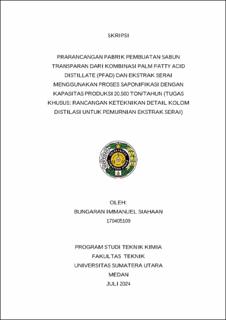| dc.description.abstract | Along with the rapid growth in the economy, population, regional development and construction from year to year, the need for energy fulfillment in all energy use sectors nationally is also increasing. So far, the world's energy needs have been met by non-renewable natural resources, such as natural gas, oil, coal and so on.
Cosmetics are materials or materials intended for use on the external parts of the human body, namely the epidermis, hair, nails, lips, and genital organs (external parts) or teeth and oral mucous membranes, especially to clean, perfume, change the appearance, improve body odor, protect or maintain the body in good condition. Soap is a mixture of sodium compounds with fatty acids which is used as a body cleansing agent, in the form of solid, foam with or without additives, apart from not causing irritation to the skin. One innovation to make soap look more attractive is to make solid soap transparent. This type of soap has softer foam compared to non-transparent soap. Soap is made by chemically reacting between sodium base or potassium base and fatty acids derived from animal and vegetable oils (saponification process).
The need for the soap industry in Indonesia as an alternative in developing renewable and environmentally friendly energy sources, amidst the current dense population conditions, is very necessary. The need for soap is also increasing and is predicted to increase every year. There is quite large potential for natural transparent soap products as a means of meeting people's basic needs to develop additional soap factories in Indonesia and increase the influence of soap exports to various countries.
So a transparent soap manufacturing factory was designed with an annual capacity of 20,500 tons through a triglyceride saponification process using palm fatty acid distillate (PFAD) as raw material and lemongrass extract as a supporting material. The scope of factory design includes process descriptions and process flow sheets, mass balance, energy balance, equipment specifications, K3 (Occupational Health and Safety) instruments, utilities, factory location and layout, company management, and economic analysis.
Keywords: Saponification, Transparent Soap, Palm Fatty Acid Distillate. | en_US |


